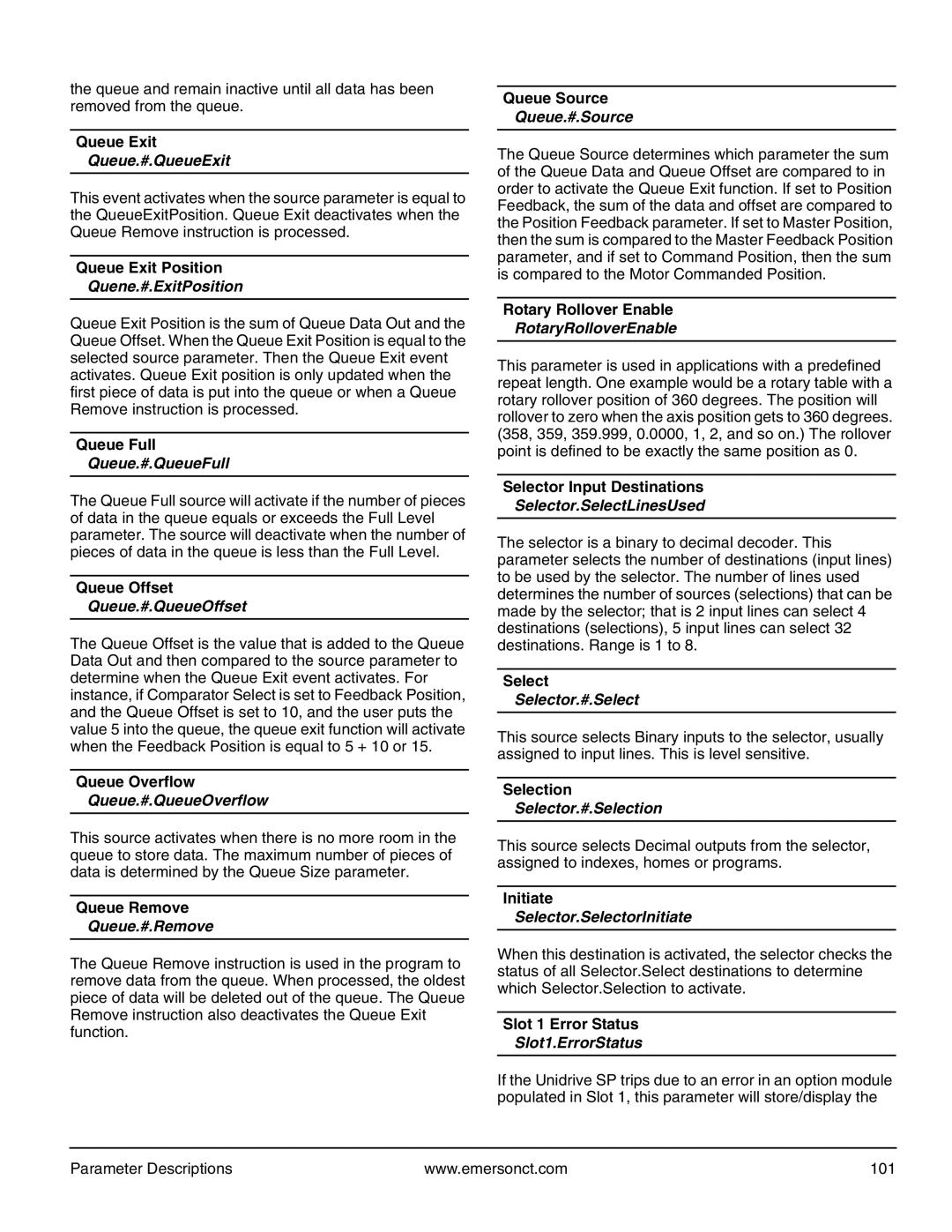
the queue and remain inactive until all data has been removed from the queue.
Queue Exit
Queue.#.QueueExit
This event activates when the source parameter is equal to the QueueExitPosition. Queue Exit deactivates when the Queue Remove instruction is processed.
Queue Exit Position
Quene.#.ExitPosition
Queue Exit Position is the sum of Queue Data Out and the Queue Offset. When the Queue Exit Position is equal to the selected source parameter. Then the Queue Exit event activates. Queue Exit position is only updated when the first piece of data is put into the queue or when a Queue Remove instruction is processed.
Queue Full
Queue.#.QueueFull
The Queue Full source will activate if the number of pieces of data in the queue equals or exceeds the Full Level parameter. The source will deactivate when the number of pieces of data in the queue is less than the Full Level.
Queue Offset
Queue.#.QueueOffset
The Queue Offset is the value that is added to the Queue Data Out and then compared to the source parameter to determine when the Queue Exit event activates. For instance, if Comparator Select is set to Feedback Position, and the Queue Offset is set to 10, and the user puts the value 5 into the queue, the queue exit function will activate when the Feedback Position is equal to 5 + 10 or 15.
Queue Overflow
Queue.#.QueueOverflow
This source activates when there is no more room in the queue to store data. The maximum number of pieces of data is determined by the Queue Size parameter.
Queue Remove
Queue.#.Remove
The Queue Remove instruction is used in the program to remove data from the queue. When processed, the oldest piece of data will be deleted out of the queue. The Queue Remove instruction also deactivates the Queue Exit function.
Queue Source
Queue.#.Source
The Queue Source determines which parameter the sum of the Queue Data and Queue Offset are compared to in order to activate the Queue Exit function. If set to Position Feedback, the sum of the data and offset are compared to the Position Feedback parameter. If set to Master Position, then the sum is compared to the Master Feedback Position parameter, and if set to Command Position, then the sum is compared to the Motor Commanded Position.
Rotary Rollover Enable
RotaryRolloverEnable
This parameter is used in applications with a predefined repeat length. One example would be a rotary table with a rotary rollover position of 360 degrees. The position will rollover to zero when the axis position gets to 360 degrees. (358, 359, 359.999, 0.0000, 1, 2, and so on.) The rollover point is defined to be exactly the same position as 0.
Selector Input Destinations
Selector.SelectLinesUsed
The selector is a binary to decimal decoder. This parameter selects the number of destinations (input lines) to be used by the selector. The number of lines used determines the number of sources (selections) that can be made by the selector; that is 2 input lines can select 4 destinations (selections), 5 input lines can select 32 destinations. Range is 1 to 8.
Select
Selector.#.Select
This source selects Binary inputs to the selector, usually assigned to input lines. This is level sensitive.
Selection
Selector.#.Selection
This source selects Decimal outputs from the selector, assigned to indexes, homes or programs.
Initiate
Selector.SelectorInitiate
When this destination is activated, the selector checks the status of all Selector.Select destinations to determine which Selector.Selection to activate.
Slot 1 Error Status
Slot1.ErrorStatus
If the Unidrive SP trips due to an error in an option module populated in Slot 1, this parameter will store/display the
Parameter Descriptions | www.emersonct.com | 101 |
